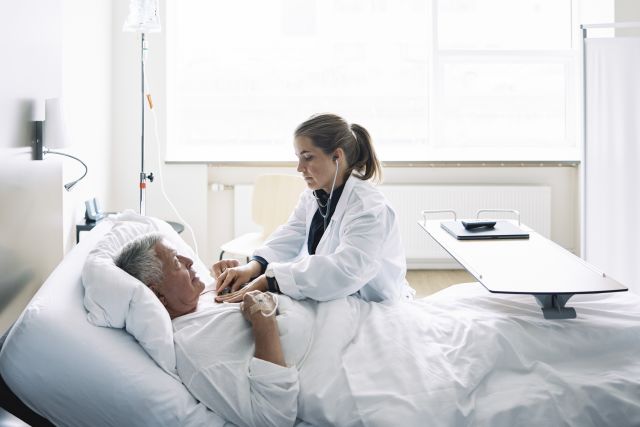Modern emergency rooms (ERs) are often models of speed and efficiency. When your life or limb is on the line, you want a team of healthcare providers that springs into action—drawing blood samples, performing medical tests, stitching you up—as quickly as possible.
While efficiency is still important when treating seniors, some steps shouldn’t be rushed when caring for an older individual. Senior ERs are proving that taking the time to thoroughly learn a senior’s health history, while also accommodating their special needs, can be just as life saving as hurried tests and procedures.
Here’s how this new approach to emergency medicine is improving health outcomes across the country and changing the way hospitals care for older adults.
Why do seniors need a different type of emergency room?
“The older population has a whole arena of different medical needs compared to younger adults,” says Henry Kurusz, MD, Medical Director of the emergency department at St. Petersburg General Hospital in Saint Petersburg, Florida. “For example, the metabolism of an older adult works differently—that affects how much and which types of medication they should receive.”
To work in a senior ER, healthcare providers typically undergo extra training on the safest drugs and doses for older adults. That knowledge can help prevent side effects including confusion and excessive sleepiness, which older adults are prone to in the hospital.
Staff members are also taught how to:
- Tailor medical tests, procedures and nursing care to meet the health needs of seniors
- Assess the mental and physical functions of older adults
- Properly communicate with individuals who have memory or thinking problems. This allows the ER staff to collect more health information from people. At the same time, it eases the stress and tension that can come from answering difficult medical questions about things like past surgeries or complications.
The physical environment of a senior ER is set up to make care safer and more comfortable as well.
How can the environment of a senior ER impact care?
The physical comforts provided in a senior ER are certainly a welcome relief for anyone who comes through the door, says Kurusz.
These seemingly simple changes to the ER environment can actually go a long way in improving the overall quality of care that you receive. Physical changes to the ER setting help to meet key medical needs of older adults like:
- Increased sensitivity to cold: Heated blankets are provided so you don’t have to shiver in the cold hospital air.
- Joint pain: “Many seniors have joint problems like arthritis, so the thin mattresses in most ERs are too uncomfortable for them. Instead, we provide thicker, softer mattresses,” says Kurusz. The extra cushioning feels better, plus it can help to prevent pressure ulcers, or bed sores. These wounds come from the pressure that builds up against your skin when you lie in one position for too long. If you’re at high risk for pressure ulcers, your nurse may provide additional cushioning and help you to reposition every two hours.
- Fragile skin: “The skin of older adults is more delicate, so healthcare providers need to take caution when starting IVs, placing bandages and applying medical equipment,” explains Kurusz. Senior ERs are stocked with the proper bandages and supplies for elderly skin, plus staff members know the correct way to apply and remove adhesives to prevent abrasions. Preventing and protecting open wounds is essential in the hospital, where antibiotic-resistant germs could cause infections to turn deadly.
- Hearing and vision difficulties: Patient handouts and signs are printed with large fonts that are easier to see; sound enhancing headphones may be used to help people hear their healthcare providers. Also, iPad applications are used to help with both hearing and vision challenges as they arise.
- Risk for falls: Confusion, weakness and balance problems all can put older adults at higher risk for falls. “Something as simple as changing the floor has a large impact on senior safety. Instead of linoleum floors, we’ve installed non-skid floors—they’re much more protective than the slick material,” says Kurusz.
What’s more, senior ERs are supportive and welcoming towards caregivers. “We welcome caregivers, family members, anybody who can support the individual and provide health information, especially for those with dementia,” explains Kurusz.
Having someone at the bedside can make the discharge process easier. “It’s vitally important to send elders home with a clear understanding of their diagnosis, their plan of care and their follow-up appointments,” Kurusz adds. Senior ERs accomplish this by involving specially trained social workers to support you and your family throughout the discharge process. A geriatric social worker can put you in touch with community resources and coordinate follow-up appointments.
Include a senior ER in your emergency action plan
Even if you’re in good health, it’s important to put an emergency action plan in place. In case of an emergency, your spouse or caregiver should have:
- A typed-up list of your current medications and medical conditions
- Instructions on which emergency room you’d like to be taken to
- An up-to-date document like a living will, which clearly expresses your medical wishes
Discuss this plan with your loved ones in advance. If there’s a senior ER in your area, let them know that you’d like to be taken there.
The number one thing is to talk to your family, says Kurusz. Frank conversations between people and their caregivers are extremely important and will help your ER team take the best possible care of you.






